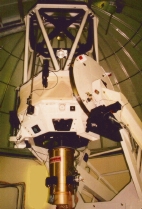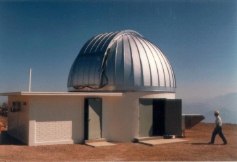
The two 2MASS Cassegrain-focus equatorial-mount reflector telescopes are identical in construction, and each has a primary mirror diameter of 1.3 meters. One telescope is located on Mt. Hopkins in Arizona (left), and the other on Cerro Tololo, along the Andes mountains in Chile (facility seen at right). Each telescope was equipped with a three-channel camera, each channel consisting of a 256-pixel × 256-pixel detector array, capable of observing the sky simultaneously at wavelength bands centered at wavelengths 1.25 micrometers, 1.65 micrometers, and 2.17 micrometers. (1 micrometer, abbreviated 1 µm, is one-millionth of a meter in length.) These bands are colloquially known by astronomers as "J", "H", and "K-short" (or "Ks"). The refrigerated dewar containing the camera is the brass canister hanging below the telescope. Computers operated each telescope's motion with respect to the sky; the motion of the much-smaller secondary mirror (seen near the top of the telescope); and the dark shutters of the three channels and digital "readout" of the three detector arrays.

 An observing "schedule file" was sent down from UMass to the telescope operator
at each
of the two facilities for each night. Computers used these files to
automatically control the telescopes throughout the night. The operator at
each facility monitored the telescope operations and the acquiring of data.
Each morning the digital data were written to magnetic tape storage, and the
tapes were sent to IPAC. Each night's data were put through an automated
"pipeline" of computer programs, which convert
the raw images made by the
telescopes into final processed images and
catalogs containing star and galaxy
brightnesses and positions. These data were assessed
for quality, through some human intervention. If these data passed muster,
they were included as part of the enormous 2MASS
database, from which
a digital image atlas of the sky and
catalogs of point sources and extended sources,
freely available to astronomers and the public at large, were assembled and
distributed.
An observing "schedule file" was sent down from UMass to the telescope operator
at each
of the two facilities for each night. Computers used these files to
automatically control the telescopes throughout the night. The operator at
each facility monitored the telescope operations and the acquiring of data.
Each morning the digital data were written to magnetic tape storage, and the
tapes were sent to IPAC. Each night's data were put through an automated
"pipeline" of computer programs, which convert
the raw images made by the
telescopes into final processed images and
catalogs containing star and galaxy
brightnesses and positions. These data were assessed
for quality, through some human intervention. If these data passed muster,
they were included as part of the enormous 2MASS
database, from which
a digital image atlas of the sky and
catalogs of point sources and extended sources,
freely available to astronomers and the public at large, were assembled and
distributed.